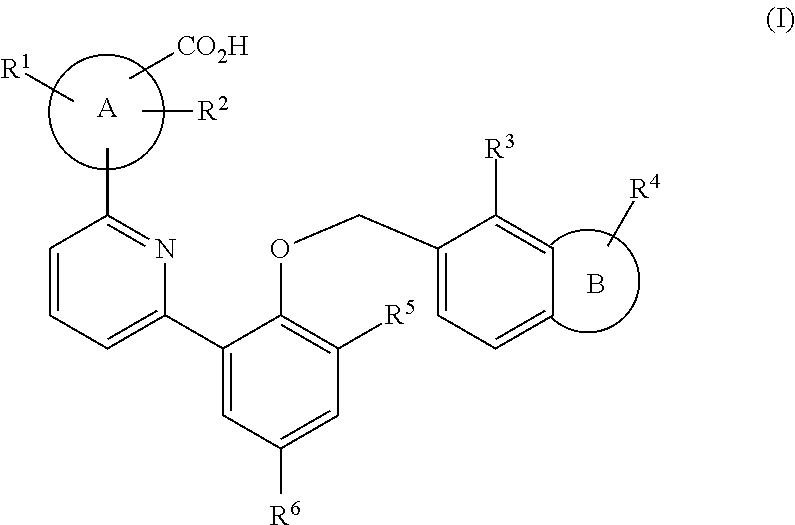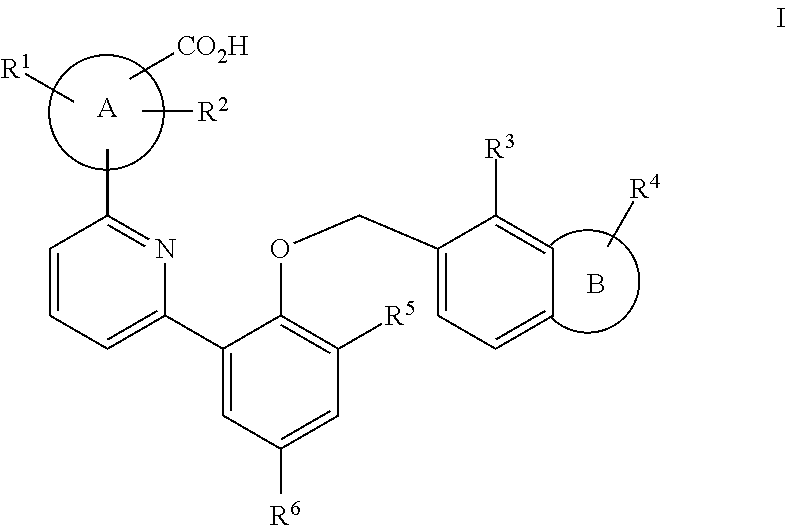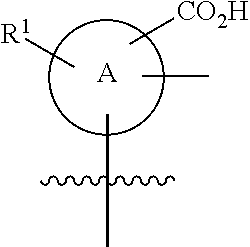Soluble guanylate cyclase activators
a technology of guanylate cyclase and activator, which is applied in the field of heterocyclic compounds, can solve the problems that poor human exposure to poor soluble compounds
- Summary
- Abstract
- Description
- Claims
- Application Information
AI Technical Summary
Benefits of technology
Problems solved by technology
Method used
Image
Examples
example 1
Preparation of intermediate 1-[6-(2-hydroxy-5-methylphenyl)pyridin-2-yl]-5-trifluoromethyl-1H-pyrazole-4-carboxylic acid ethyl ester (1-7)
[0074]
[0075]Hydrazine hydrate (15 mL) is added in one portion to 2,6-dichloropyridine 1-1 (5.0 g, 33 mmol) at room temperature. The mixture is heated to about 108° C. for 4 h, then cooled to room temperature. The resulting solids are collected by vacuum filtration, then washed with ice-cold H2O. The solids are dried overnight in a vacuum oven to afford intermediate 1-2 (3.9 g).
[0076]Intermediate 1-2 (3.10 g, 21.6 mmol) and triethylamine (3.1 mL) are combined in MeCN (90 mL) at room temperature, then compound 1-3 (4.30 mL, 22.2 mmol) is added. The mixture is stirred for 20 min at room temperature and then heated to 60° C. for 30 additional min. The reaction is cooled to room temperature, then concentrated in vacuo. The crude product is purified by column chromatography on silica gel (using a solvent gradient of 0-30% EtOAc:heptane) to provide inter...
example 2
Preparation of 1-{6-[2-(benzo[1,2,3]thiadiazol-5-ylmethyoxy)-5-methylphenyl]pyridin-2-yl}-5-trifluoromethyl-1H-pyrazole-4-carboxylic acid (Compound 7, Table 1)
[0079]
[0080]Intermediate 1-7 (50.0 mg, 0.128 mmol) and bromide 2-8 (32.0 mg, 0.140 mmol) are combined in DMF (2 mL), then treated with Cs2CO3 (50.0 mg, 0.153 mmol). The mixture is heated to 80° C. for 1.5 h, then cooled to room temperature and diluted with water (1 mL). The mixture is then treated with LiOH.H2O (54 mg, 1.3 mmol), and stirred at 50° C. for 15 h. The resulting mixture is cooled to room temperature and acidified with 3 N HCl (1 mL), then extracted with DCM. The organic layers separated with a hydrophobic frit, then dried over Na2SO4. Concentration of the filtrate in vacuo affords the title compound (60 mg). MS, electrospray, m / z=512.3 [M+H], rt 1.13 min.
[0081]The following compound is prepared according to the procedure described in Example 2, using the appropriate starting materials and purification conditions:
[...
example 3
Preparation of intermediate (1-methyl-1,2,3,4-tetrahydroquinolin-6-yl)methanol (3-12)
[0083]
[0084]Ester 3-11 (920 mg, 4.81 mmol) and 4-dimethylaminopyridine (194 mg, 1.59 mmol) are combined in THF (20 mL), then treated in one portion with Boc2O (1.1 g, 5.0 mmol). The mixture is stirred at room temperature for 3 d, then concentrated to half of the original volume. The remaining mixture is applied to a silica gel column and purified by gradient elution (20-60% EtOAc / heptane) to afford the intermediate carbamate as a solid. The solid is subsequently dissolved in THF (12 mL) at room temperature, then treated with solid lithium aluminum hydride (LAH) powder (240 mg, 6.32 mmol). The resulting slurry is heated to 65° C. for 13 h, then cooled to room temperature and diluted with water (5 mL), EtOAc (10 mL), and saturated aqueous sodium potassium tartrate solution (10 mL). The mixture is vigorously stirred for 2 h, then the layers are separated. The combined organics are dried over Na2SO4, fi...
PUM
| Property | Measurement | Unit |
|---|---|---|
| Composition | aaaaa | aaaaa |
| Pharmaceutically acceptable | aaaaa | aaaaa |
Abstract
Description
Claims
Application Information
 Login to View More
Login to View More - R&D
- Intellectual Property
- Life Sciences
- Materials
- Tech Scout
- Unparalleled Data Quality
- Higher Quality Content
- 60% Fewer Hallucinations
Browse by: Latest US Patents, China's latest patents, Technical Efficacy Thesaurus, Application Domain, Technology Topic, Popular Technical Reports.
© 2025 PatSnap. All rights reserved.Legal|Privacy policy|Modern Slavery Act Transparency Statement|Sitemap|About US| Contact US: help@patsnap.com



